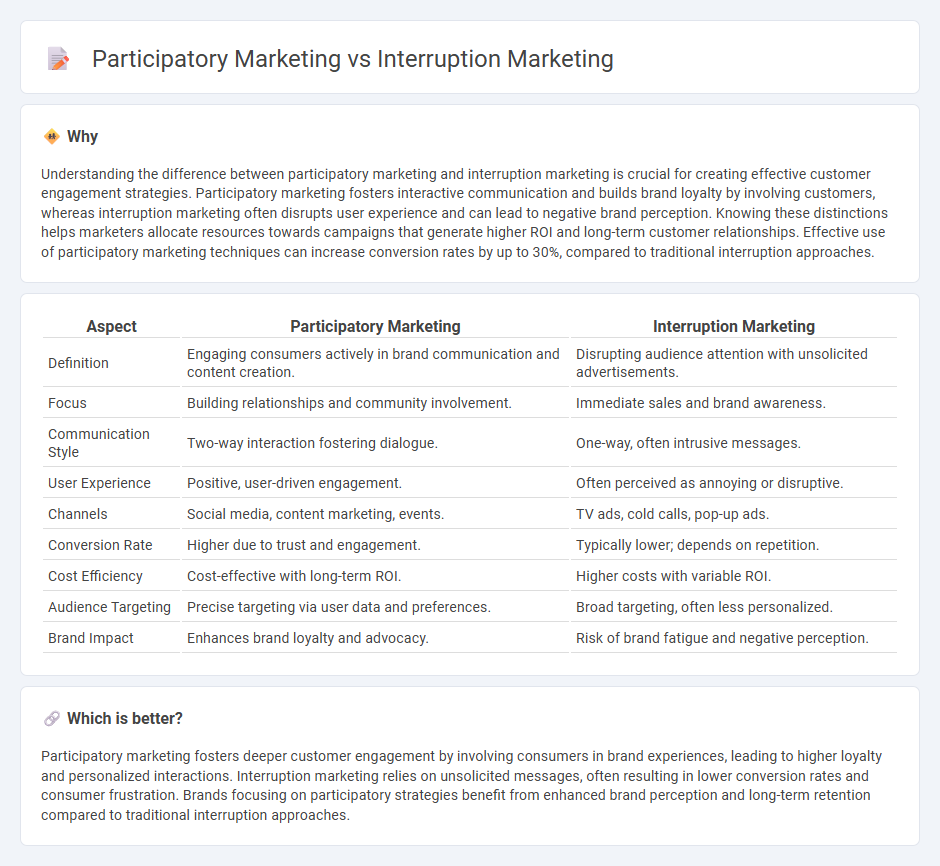
Participatory marketing engages consumers by encouraging interaction and collaboration, fostering brand loyalty and authentic connections. Interruption marketing relies on unsolicited advertisements that disrupt the consumer's experience, often leading to lower engagement. Discover how shifting from interruption to participatory strategies can transform your brand's reach and impact.
Why it is important
Understanding the difference between participatory marketing and interruption marketing is crucial for creating effective customer engagement strategies. Participatory marketing fosters interactive communication and builds brand loyalty by involving customers, whereas interruption marketing often disrupts user experience and can lead to negative brand perception. Knowing these distinctions helps marketers allocate resources towards campaigns that generate higher ROI and long-term customer relationships. Effective use of participatory marketing techniques can increase conversion rates by up to 30%, compared to traditional interruption approaches.
Comparison Table
| Aspect | Participatory Marketing | Interruption Marketing |
|---|---|---|
| Definition | Engaging consumers actively in brand communication and content creation. | Disrupting audience attention with unsolicited advertisements. |
| Focus | Building relationships and community involvement. | Immediate sales and brand awareness. |
| Communication Style | Two-way interaction fostering dialogue. | One-way, often intrusive messages. |
| User Experience | Positive, user-driven engagement. | Often perceived as annoying or disruptive. |
| Channels | Social media, content marketing, events. | TV ads, cold calls, pop-up ads. |
| Conversion Rate | Higher due to trust and engagement. | Typically lower; depends on repetition. |
| Cost Efficiency | Cost-effective with long-term ROI. | Higher costs with variable ROI. |
| Audience Targeting | Precise targeting via user data and preferences. | Broad targeting, often less personalized. |
| Brand Impact | Enhances brand loyalty and advocacy. | Risk of brand fatigue and negative perception. |
Which is better?
Participatory marketing fosters deeper customer engagement by involving consumers in brand experiences, leading to higher loyalty and personalized interactions. Interruption marketing relies on unsolicited messages, often resulting in lower conversion rates and consumer frustration. Brands focusing on participatory strategies benefit from enhanced brand perception and long-term retention compared to traditional interruption approaches.
Connection
Participatory marketing engages consumers by encouraging active involvement and feedback, fostering brand loyalty and personalized experiences. Interruption marketing interrupts consumer activities with ads, often leading to negative perceptions due to its intrusive nature. These two marketing approaches connect through their contrasting interactions with the audience, influencing consumer engagement and response effectiveness.
Key Terms
**Interruption Marketing:**
Interruption marketing relies on capturing consumer attention through unsolicited ads like TV commercials, pop-ups, and cold calls, often interrupting the user's experience. This approach emphasizes broad reach and immediate impact, but may lead to lower engagement and increased ad resistance. Explore more about how businesses balance interruption strategies with modern marketing trends.
Advertisement Placement
Interruption marketing relies on placing advertisements in high-traffic areas such as TV commercials, pop-up ads, and banner ads designed to capture immediate attention, often disrupting the user experience. Participatory marketing integrates ads within interactive platforms like social media, influencer collaborations, and user-generated content, encouraging engagement and co-creation with the audience. Explore the nuances of advertisement placement strategies to harness the full potential of your marketing campaigns.
Push Strategy
Interruption marketing relies on push strategies by delivering promotional messages directly to consumers through channels like TV ads, cold calls, or pop-up ads, aiming for immediate attention without prior engagement. In contrast, participatory marketing encourages active consumer involvement and interaction, often leveraging social media or content co-creation, which aligns more with pull strategies rather than push. Explore more about how these approaches impact brand engagement and consumer behavior.
Source and External Links
Interruption marketing - Wikipedia - Interruption marketing, also known as outbound marketing, promotes products through continuous advertising and sales efforts that interrupt consumers, including tactics like telemarketing, cold calling, and TV ads, typically delivering quick results but often considered annoying.
Discover the Power of Interruption Marketing - Tips and... - Strikingly - Interruption marketing interrupts consumers' daily activities with promotional messages to generate immediate engagement and responses, enhancing brand visibility and driving quick customer action through urgent campaigns.
Interruption Marketing - MarketerHire - This marketing approach effectively captures attention by interrupting routines, is cost-effective and flexible for targeting specific groups, with successful examples including T-Mobile pop-up ads and Old Spice pre-roll YouTube ads.
 dowidth.com
dowidth.com